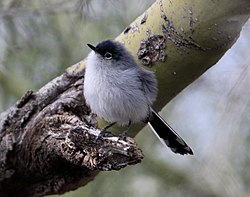Black-tailed gnatcatchers live in pairs all year, defending their territory and foraging in trees and low shrubs for a wide variety of small insects and some spiders. Unlike the blue-grey gnatcatcher, the black-tailed variety rarely catches insects in midair.
Breeding
The nest is an open-cup, built by both sexes, and is typically found in low shrubs less than five feet off the ground. If available at the nesting site, desert mistletoe, Phoradendron californicum , is often used as the substrate for the nest, which provides nice concealment. It is constructed of a variety of materials including weeds, grass, strips of bark, spider webs and plant fibers. It is lined with finer, softer matter. Three to five bluish-white eggs with red-brown dots are incubated by both parents and take 14 days to hatch. The young are fed by both parents, and leave the nest 10 to 15 days after hatching. Even though cowbirds often lay eggs in this species' nests, and the pair end up raising cowbird young, the black-tailed gnatcatcher population seems to be holding up well. [3]


